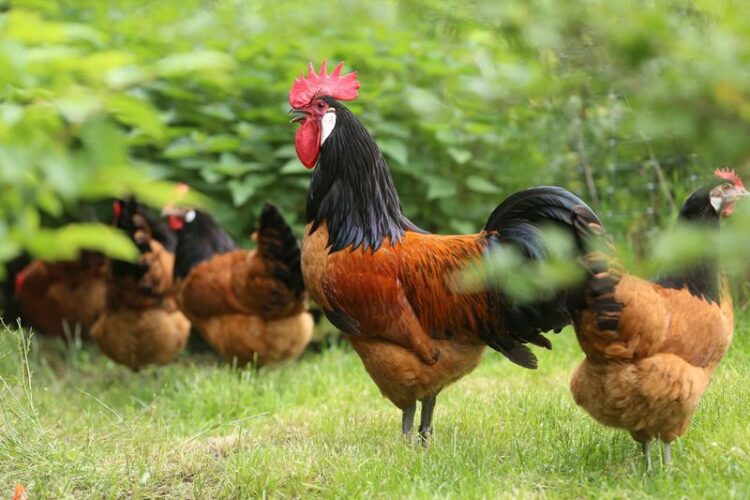Broad beans versus soybeans as feedstuff for dual-purpose chickens

Cockerel and hens from the Vorwerkhuhn breed, a traditional German dual-purpose breed that is suitable for both meat and egg-laying.
Juliane Fellner
Current practices of the poultry industry have raised ethical and ecological concerns: ethical concerns include the culling of day-old male chicks of egg-laying breeds; ecological concerns include the import of large quantities of soybeans for feedstuff.
Now a research team at the University of Göttingen has investigated alternatives such as using a regional protein crop like broad beans (also known as faba or fava beans), and dual-purpose chicken breeds (ie suitable for both meat and egg-laying).
They found that using broad beans as feed and dual-purpose breeds were both suitable alternatives which did not impact the quality of chicken meat. Their results were published in Foods.
As part of the “Potentials of sustainable use of regional breeds and regional protein feed in poultry production” (PorReE) project; this study focuses on adult cockerels of two local dual-purpose chicken breeds (Vorwerkhuhn and Bresse Gauloise) and one high-performing laying line (White Rock) fattened on feed where the main protein sources were soybean meal and two broad bean (Vicia faba) diets with different composition.
This study focused on the effect of the diet on meat quality characteristics, including sensory analysis, of these particular breeds. The results of physicochemical and sensory analyses show that broad beans can be included in poultry feed without negatively impacting the quality of the product.
Broad beans’ nutritional composition makes them a suitable replacement for soybeans as a protein source in poultry feed and they have the added advantage of improving the soil quality by fixing nitrogen. First author Cynthia Escobedo del Bosque at the University of Göttingen says: “Broad beans are widely cultivated legumes that would help local agricultural industries by granting them a greater independence since they would be freed up from relying on soy imports and could control the price.”
The use of dual-purpose breeds has only been the subject of research in recent years. These breeds cannot keep up with the laying and/or fattening performance of specialized breeds. “Our research shows that these breeds produce high quality eggs and chicken meat but at a smaller volume,” explains coauthor Professor Daniel Mörlein from the University of Göttingen. He adds: “This means the cost will be higher, but if consumers would be willing to pay more, animal welfare and genetic diversity can be improved.”
Four research groups at the Faculty of Agricultural Sciences, University of Göttingen, are currently examining the foundations for a more sustainable and socially-accepted poultry production system. Product perception as well as consumer acceptance studies are commonly conducted in the faculty’s modern sensory laboratory.
Wissenschaftliche Ansprechpartner:
Cynthia Escobedo del Bosque
University of Göttingen
Faculty of Agricultural Sciences, Department of Agroeconomics and Rural Development
Marketing for Food and Agricultural Products
Platz der Göttinger Sieben 5, 37073 Göttingen, Germany
Tel: +49 (0)551 39-26249
Email: cynthia.escobedo@uni-goettingen.de
http://www.uni-goettingen.de/en/564473.html
Professor Daniel Mörlein
University of Göttingen
Faculty of Agricultural Sciences, Department of Animal Sciences
Albrecht-Thaer-Weg 3, 37075 Göttingen, Germany
Email: daniel.moerlein@uni-goettingen.de
http://www.uni-goettingen.de/en/86980.html
Originalpublikation:
Escobedo del Bosque, Cynthia et al: Meat Quality Parameters and Sensory Properties of One High-Performing and Two Local Chicken Breeds Fed with Vicia faba. (Foods, open access) DoI: 10.3390/foods9081052
Media Contact
All latest news from the category: Agricultural and Forestry Science
Newest articles

A universal framework for spatial biology
SpatialData is a freely accessible tool to unify and integrate data from different omics technologies accounting for spatial information, which can provide holistic insights into health and disease. Biological processes…

How complex biological processes arise
A $20 million grant from the U.S. National Science Foundation (NSF) will support the establishment and operation of the National Synthesis Center for Emergence in the Molecular and Cellular Sciences (NCEMS) at…

Airborne single-photon lidar system achieves high-resolution 3D imaging
Compact, low-power system opens doors for photon-efficient drone and satellite-based environmental monitoring and mapping. Researchers have developed a compact and lightweight single-photon airborne lidar system that can acquire high-resolution 3D…





















